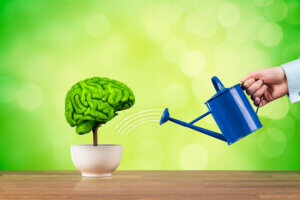The human brain is one of the most mysterious and fascinating structures in the world. It seems that the more we learn about it, the more there is to discover. Over the years, several myths about the brain have been circulated and established as absolute truths. In this article, we will review five common myths about the brain and explore which ones are true and which are not. Can you guess?
Myth 1: We only use 10% of our brain
Despite being widely recognized, this myth is not true. We use our entire brain. This myth has been around for many years and likely gained strength following the publication of fMRI studies – a brain imaging tool that displays brain activity. These studies often show images depicting highly localized brain activity (like the accompanying image). Firstly, these images do not represent the full brain activity at any given moment but rather relative activity – areas with more color are simply more active than others. Secondly, it does not mean that we only use a small portion of our brain! Different areas of the brain are activated at different times according to need. For example, an area involved in cycling may not necessarily be active while drinking coffee. In fact, we don’t even have enough energy to use our entire brain simultaneously: despite the brain weighing only 2% of our body weight, it consumes about 20% of our energy, so increasing its activity would require more energy than our bodies can provide!
Myth 2: Every brain has a dominant side – right or left
Have you come across online quizzes promising to reveal if your brain is “right” or “left” dominant? Don’t rush to believe that you have only one dominant side because the truth is that most of our actions depend on both sides. The coordination between the right and left sides of the brain is essential for nearly everything we do, from tying shoelaces to developing medications. It is true that some specific actions are controlled by specific regions (such as language comprehension, which is associated with the left hemisphere), but those regions do not work alone; they collaborate with other brain regions. The combined activity of both hemispheres creates the overall balance that is us, so the assumption that one side controls more is simply incorrect. Moreover, while there is no evidence supporting the idea of personality types based on dominant hemispheres, there is plenty of evidence refuting it. For example, in 2012, psychologists at the University of British Columbia found that creative thinking activates a widespread neural network without favoring one side of the brain over the other.
Myth 3: There is a female brain and a male brain
We often encounter statements claiming that men are generally strong in mathematical and technical skills, while women are strong in social abilities, and the reason for this is the structure and wiring of the brain. This urban legend is based on gender stereotypes and enlists science for support, or more accurately, pseudoscience. Although neuroimaging studies have found some differences between male and female brains (such as differences in brain weight), these differences are not consistent and uniform among all individuals, making it impossible to determine a typical female or male brain. Furthermore, it is impossible to infer behavioral differences from brain differences alone. If an area responsible for emotional processing (such as the amygdala) is larger in men, does it mean they are better at processing emotions, or is it a compensatory mechanism to enhance their ability to process emotions? In conclusion, our world does not treat men and women the same, so the brain differences between men and women may actually reflect different life experiences and exposures rather than generating them.
Myth 4: We remember positive emotional events better
Is there any truth to this myth? Yes! Life experience teaches us that the more emotional an event is, the stronger the memory. What leaves an impression on us, whether positive or negative, will continue to accompany us in our memories for years. However, it’s not just emotions that help us remember things. In fact, we remember things better when we allocate more “resources” to them – attention, thought, analysis, and depth. The more we deeply process new information, the better we remember it. Emotions are one way of allocating resources, but certainly not the only one.
Myth 5: The brain stops developing in the early 20s
There is some truth to this myth: the brain does finish developing by the mid-20s, with the prefrontal cortex, responsible for “higher” functions like weighing decisions, being the last to mature. However, the brain continues to change constantly even after it has fully matured. Every new thought, skill, or memory leads to the formation of new connections between brain cells, and damage to a specific area will cause changes in the functioning of other areas to compensate for the damage. The adult brain doesn’t continue to grow in size, but it does change in its quality or internal structure. Research from the past decade has even shown the creation of new nerve cells in specific regions of the adult brain, so there is no doubt – our brain continues to renew itself regularly.



